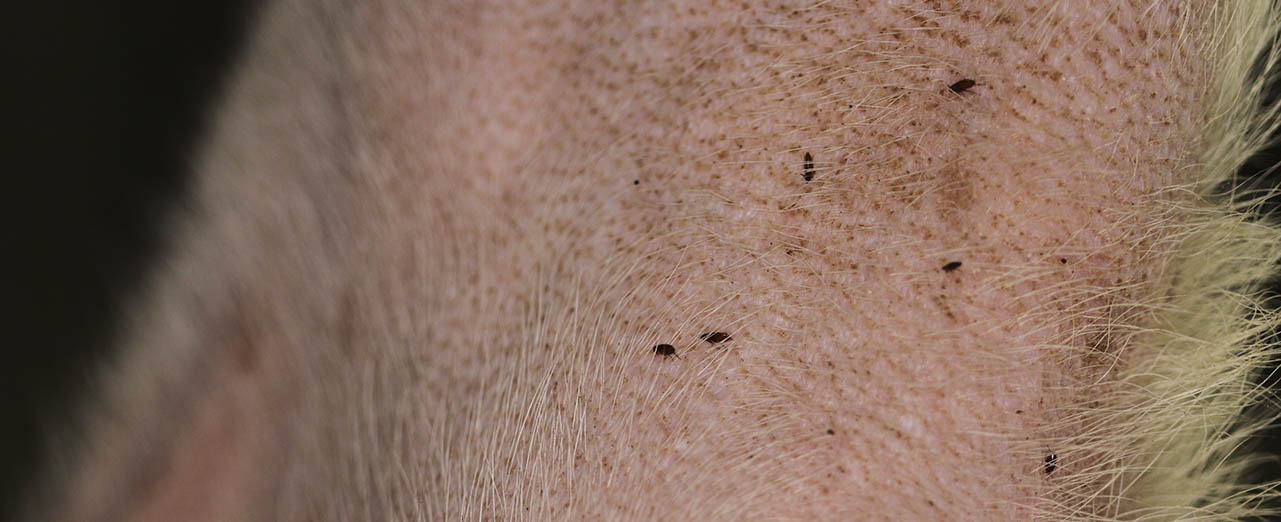If your dog has fleas, you’ll see tiny black specks and excessive scratching. Dry skin often causes flaking and redness.
Fleas and dry skin can both cause your dog discomfort, but they have distinct signs. Fleas are tiny parasites that feed on your dog’s blood, leading to itching, redness, and visible flea dirt. Dry skin, on the other hand, results in flakiness, dandruff, and occasional scratching.
Identifying the exact cause helps you choose the right treatment. Examine your dog’s skin closely. Use a flea comb to check for fleas or their droppings. If you find none, consider environmental factors like low humidity or allergies that might cause dry skin. Proper diagnosis ensures your furry friend stays healthy and comfortable.

Credit: nexgard.com.au
Common Symptoms
Is your dog constantly scratching? You might wonder if it’s fleas or dry skin. Understanding the common symptoms can help you figure this out. Below are key signs to watch for.
Itching And Scratching
Dogs with fleas itch and scratch often. Fleas bite and cause discomfort. You may notice your dog biting its skin. This is a strong sign of fleas.
Dry skin can also cause itching. Dry air or allergies might be the culprit. Check your dog’s skin for signs of dryness.
- Frequent scratching
- Constant biting at skin
- Visible fleas or flea dirt
Red And Inflamed Skin
Flea bites can make your dog’s skin red and inflamed. Look for small red bumps or spots. Flea bites are usually found on the back or tail.
Dry skin, on the other hand, can cause flakiness. You might see white flakes on your dog’s coat. The skin may appear cracked or rough.
| Condition | Symptoms |
|---|---|
| Fleas | Red bumps, inflamed skin, flea dirt |
| Dry Skin | Flakiness, white flakes, rough patches |
Both fleas and dry skin cause discomfort. Observing the symptoms closely can help you determine the issue. Always consult your vet for an accurate diagnosis.

Credit: www.doglyness.com
Flea Identification
Identifying fleas on your dog can be tricky. Fleas are tiny and move fast. Knowing what to look for helps you tell if it’s fleas or dry skin.
Visible Fleas
Visible fleas are the most obvious sign. Fleas are small, brown insects. They are about the size of a sesame seed. Use a flea comb to check your dog’s fur. Part the fur and look for small, moving insects. Check the neck, belly, and tail areas closely.
| Signs | Description |
|---|---|
| Movement | Fleas jump and crawl quickly. |
| Color | Fleas are brown or black. |
| Size | Fleas are about 1-2 mm long. |
Flea Dirt
Flea dirt is flea feces. It looks like small black specks. Flea dirt is often found in the dog’s fur. Use a white paper towel to find flea dirt. Wet the paper towel and rub it on your dog’s fur. If the black specks turn red, it’s flea dirt. The red color means it’s digested blood from your dog.
- Check your dog’s bedding for flea dirt.
- Look in common flea areas: neck, groin, and tail.
- Flea dirt may look like black pepper.
Dry Skin Indicators
Recognizing whether your dog has fleas or just dry skin can be tricky. Knowing the dry skin indicators can help you identify and treat the issue correctly. Here are some key signs to look for:
Flaky Skin
One of the most obvious signs of dry skin is flaky skin. You may notice small white flakes on your dog’s fur. This can be more visible in certain areas, like the back or belly. These flakes are dead skin cells shedding more than normal. A good way to spot them is by parting your dog’s fur and looking closely.
Flaky skin may cause your dog to scratch often. This can lead to more irritation and even open sores. It’s important to address this issue to keep your dog comfortable.
Dull Coat
A dull coat is another sign of dry skin. Healthy fur should be shiny and smooth. If your dog’s coat looks dull or feels rough, it may indicate dryness. A lack of natural oils can make the fur lose its shine.
A dry coat can also be a sign of poor nutrition or allergies. Make sure your dog is eating a balanced diet. Foods rich in omega-3 fatty acids can help improve coat health.
| Indicator | Description |
|---|---|
| Flaky Skin | Visible white flakes on fur, increased scratching |
| Dull Coat | Fur looks dull, feels rough, lacks natural shine |
If you notice these dry skin indicators, consider using moisturizing shampoos. Regular grooming can also help distribute natural oils. Always consult your vet for persistent issues.

Credit: www.doglyness.com
Behavioral Changes
Understanding your dog’s behavior can help identify if they have fleas or just dry skin. Dogs with fleas often exhibit specific behavioral changes. Recognizing these signs can lead to timely treatment.
Restlessness
Restlessness is a common sign of fleas. Dogs with fleas can’t sit still. They scratch and bite themselves frequently. This constant movement is due to the discomfort caused by flea bites.
Dogs with dry skin may also be restless. The difference lies in the intensity. Dogs with fleas are usually more agitated. They move around more and seem unable to find a comfortable position.
Excessive Grooming
Excessive grooming is another indicator. Dogs with fleas groom themselves more than usual. They nibble and chew at their fur to relieve itching.
Dry skin can also cause excessive grooming. Dogs with dry skin scratch and lick themselves, but it tends to be less frequent. Fleas cause more irritation, leading to more persistent grooming.
| Behavior | Fleas | Dry Skin |
|---|---|---|
| Restlessness | High | Moderate |
| Excessive Grooming | Frequent | Less Frequent |
Notice these behavioral changes in your dog? It could be fleas or dry skin. Knowing the signs helps you take the right action.
Flea Allergy Dermatitis
If your dog is constantly scratching, it could be Flea Allergy Dermatitis. This condition is triggered by flea bites. Dogs with this allergy react to flea saliva. The reaction causes extreme itching and discomfort.
Hot Spots
Hot spots are areas of inflamed skin. They appear red, moist, and irritated. Dogs often scratch or lick these spots. This makes the irritation worse. Hot spots are a common sign of flea allergies.
| Hot Spot Symptoms | Details |
|---|---|
| Redness | Inflamed and red areas on the skin. |
| Moisture | Wet and oozing spots. |
| Itching | Frequent scratching or licking. |
Hair Loss
Hair loss is another sign of flea allergy. Dogs with this condition often lose hair in patches. The hair loss is usually near the tail or hindquarters. Flea bites cause intense itching, leading to excessive scratching. This results in hair loss.
- Patches of missing fur.
- Thinning hair around the tail.
- Bald spots on the hind legs.
Home Inspection
Inspecting your home is essential to identify if your dog has fleas or just dry skin. You can find clues in your dog’s surroundings. Below are steps to help you conduct a thorough home inspection.
Inspecting Bedding
Your dog’s bed is the first place to check. Fleas often hide in bedding. Shake out the bedding outdoors. Look for small black specks. These are flea droppings. If you see them, your dog likely has fleas. Also, check for tiny white specks. These are flea eggs.
Use a vacuum cleaner to clean the bedding. Wash it in hot water. Dry it on a high heat setting. This will kill fleas and eggs.
Checking Carpets
Fleas can hide in your carpets. Walk around your house. Look for small jumping insects. These are adult fleas. Use a flashlight to see better. Part the carpet fibers. Inspect the base of the carpet. Fleas and their dirt may be there.
Vacuum your carpets thoroughly. Use a vacuum with a HEPA filter. Dispose of the vacuum bag immediately. You can also use a steam cleaner. The heat will kill fleas and their eggs.
Veterinary Diagnosis
Identifying whether your dog has fleas or just dry skin can be challenging. A veterinary diagnosis is crucial for accurate treatment. Veterinarians use various methods to determine the cause of your dog’s discomfort.
Skin Scrapings
Veterinarians often perform skin scrapings to diagnose skin conditions. This involves gently scraping the dog’s skin to collect samples. The samples are then examined under a microscope. This helps to identify fleas, mites, or other parasites. Skin scrapings are effective in diagnosing mange and other skin disorders.
Blood Tests
Blood tests can provide a clear picture of your dog’s health. These tests can detect underlying conditions that may cause dry skin. Blood tests can also reveal allergic reactions and infections. Veterinarians use blood tests to rule out other health issues.
| Method | Purpose |
|---|---|
| Skin Scrapings | Identify parasites like fleas and mites |
| Blood Tests | Detect allergies and infections |
Early diagnosis can prevent complications. Always consult a veterinarian for accurate diagnosis and treatment. Proper care ensures your dog remains healthy and happy.
Treatment Options
Determining if your dog has fleas or dry skin is crucial. Each condition requires different treatments. Fleas can cause severe itching and other health issues. Dry skin, on the other hand, may need moisturizing and dietary changes. Below are some effective treatment options.
Topical Treatments
Topical treatments are applied directly to your dog’s skin. These treatments can kill fleas and soothe dry skin. They come in many forms such as shampoos, creams, and spot-on treatments.
- Flea Shampoos: These shampoos kill fleas on contact. Use them once a week for best results.
- Anti-Itch Creams: These creams can reduce itching and inflammation. They are great for dry skin.
- Spot-On Treatments: These are applied to the back of your dog’s neck. They provide long-lasting protection against fleas.
Oral Medications
Oral medications can be very effective for treating fleas. These medications are usually given once a month. They work from the inside out, killing fleas quickly.
- Flea Pills: These pills kill adult fleas within hours. They are easy to administer.
- Chewable Tablets: These are flavored and easy for dogs to eat. They offer long-term protection.
Consult your vet before starting any treatment. Your vet can help determine the best option for your dog’s needs.
Frequently Asked Questions
How Can I Tell If My Dog Has Fleas?
Check for small, dark specks in their fur. These could be flea dirt. Also, look for excessive scratching and biting.
What Are The Signs Of Dry Skin On Dogs?
Look for flakiness, dandruff, and redness. Your dog might also scratch or lick the affected areas frequently.
Can Flea Bites Cause Dry Skin In Dogs?
Yes, flea bites can irritate your dog’s skin. This can lead to dryness and itchiness.
How Often Should I Check My Dog For Fleas?
It’s best to check your dog for fleas weekly. Regular checks help catch infestations early.
Conclusion
Distinguishing between fleas and dry skin in dogs is crucial for proper treatment. Watch for symptoms like itching and red bumps. Consult a vet for accurate diagnosis and care. Timely intervention keeps your dog healthy and happy. Regular check-ups and proper grooming can prevent future issues.
Stay attentive to your pet’s needs.








